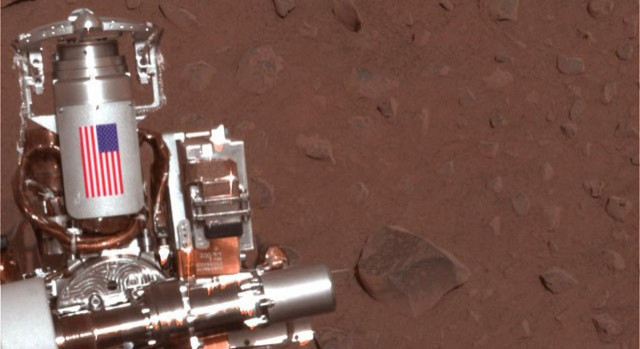Rovers Carried 9/11 Tributes to Mars, Says NASA

Ten years after the Sept. 11 terrorist attacks, NASA announced that pieces of the World Trade Center building were preserved and sent to Mars as an "interplanetary memorial."
Two aluminum shields were fashioned out metal that was salvaged from remnants of the fallen towers, and then dispatched to the Red Planet in 2003 on NASA's Spirit and Opportunity Rovers, according to a NASA press release. The shields, whcih are each embellished with an American flag, were designed to protect cables on the rovers' rock abrasion tools, also known as RATs.
The tributes were made possible by Stephen Gorevan, the founder and chairman of Honeybee Robotics, which was based less than a mile away from the World Trade Center at the time of the Sept. 11 attacks.
Gorevan said he was riding his bike to work on that morning and was less than six blocks from the Twin Towers when he heard the first plane hit. After making in to the Honeybee office, he said he and his colleagues witnessed the rest of the day's events from the roof of their building.
Although Gorevan was also a member of the Mars rover science team, he wasn't the one who came up with the idea of sending a 9/11 tribute into space. Steve Kondos, a JPL engineer -- the company building the rovers and managing the project -- working with the Honeybee team suggested using the machines as a memorial to the tragedy.
Through Gorevan's contacts, the team was able to acquire pieces of aluminum from the World Trade Center site on Dec. 1, 2001. The fragments came with a note from former Mayor Rudy Giuliani's office reading, "Here is debris from Tower 1 and Tower 2."
The Mars Exploration Rover Spirit was launched from Cape Canaveral Air Force Station, Fla., on June 10, 2003, followed by Opportunity's launch on July 7. In 2004, Gorevan told a New York Times reporter that the memorial had not been publicized at the time because it was intended to be a "quiet tribute."
"Enough time has passed. We want the families to know," he said.
Since landing on Mars, both rovers have made significant discoveries about wet environments that may have supported microbial life on ancient Mars. Spirit ended communications in 2010, although Opportunity is still active. NASA researchers plan to use the rover's rock abrasion tool on selected targets around a large crater that the machine discovered in August.
Scientists believe the Sept. 11 memorial will likely remain in good condition for million of years, due to the cold, dry environment on the Red Planet.
© Copyright IBTimes 2024. All rights reserved.





















